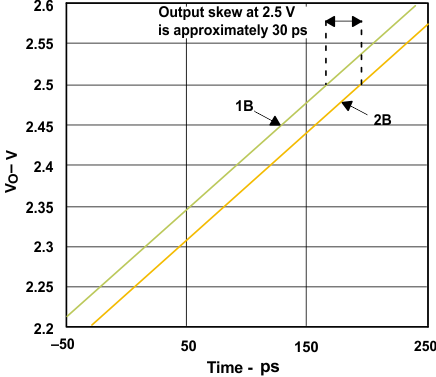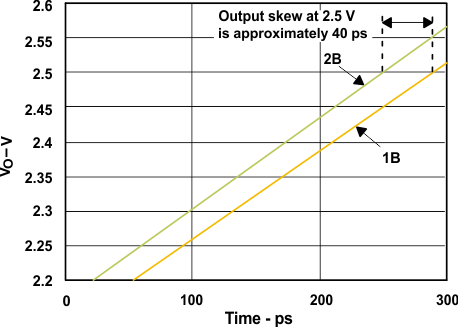SCDA008C June 2021 – November 2021 CD4052B , TS3A225E , TS3A44159
- Trademarks
- 1Introduction
- 2Semiconductor Switches
- 3Basic Signal-Switch Structures
- 4Key Concerns in Digital-Switch Applications
- 5Signal Switch Families
- 6Applications
- 7Conclusion
- 8References
- 9Revision History
-
A Test
Measurement Circuits
- A.1 Measurement Setup for ron
- A.2 Measurement Setup for VO vs VI Characteristics
- A.3 Voltage-Time Waveform Measurement (Switch On)
- A.4 Voltage-Time Waveform Measurement (Switch Off)
- A.5 Output-Skew Measurement
- A.6 Simulation Setup for Undershoot Measurement
- A.7 Laboratory Setup for Attenuation Measurement
- A.8 Laboratory Setup for Off Isolation Measurement
- A.9 Laboratory Setup for Crosstalk Measurement
5.3.1.4 Output Skew
Output skew is a measure of the variation of ron over the channels in a multi bit switch. This is specifically significant when switching differential signals. For minimal signal distortion and noise in differential signaling, the variation of ron should be as small as possible. Output skew at a specific voltage can be determined by measuring the time difference of the output voltage at various channels. Figure 5-15 and Figure 5-16 show the output voltage of the CB3Q3306A at different channels. Output skew can be determined from this graph. For example, for –40°C at 2.5 V, the skew is approximately 30 ps, which is fairly constant from 2.2 V to 2.6 V. For 100°C, the output skew is approximately 40 ps, which is fairly constant from 2.2 V to 2.6
 Figure 5-15 Output Skew at –40°C (VCC = 3.3 V)
Figure 5-15 Output Skew at –40°C (VCC = 3.3 V) Figure 5-16 Output Skew at 100°C (VCC = 3.3 V)
Figure 5-16 Output Skew at 100°C (VCC = 3.3 V)